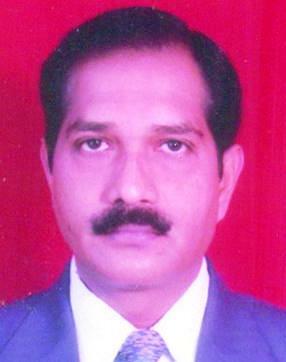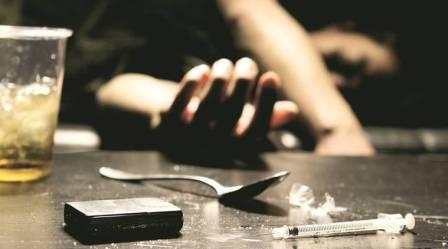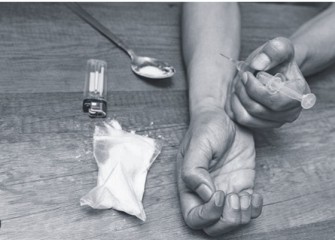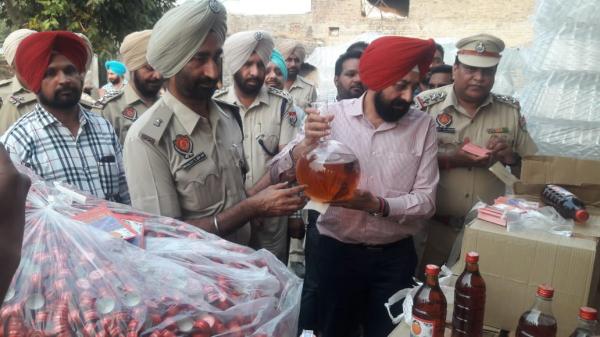

A study on “Dynamics of Drug Addiction and Abuse in North West India: Social, Economic and Political Implications” was led by Dr. Ranjit Singh Ghuman, Professor along with Dr. Gurinder Kaur, Assistant Professor and Dr. Jatinder Singh, Assistant Professor.
The research, “Dynamics of Drug Addiction and Abuse in India” is under-publication with Routledge, (United Kingdom) and the primary objective of this study was to analyse the socio-cultural and politico-economic implications of drug addiction apart from liquor and tobacco.
According to Dr Ranjit Singh Ghuman, who is Professor of Eminence, Punjab School of Economics, Guru Nanak Dev University, G.N.D.U., Amritsar, “The present study was envisaged to understand the on-going discourse on various parameters of drug addiction and abuse and then contribute to the existing understanding and literature. The main focus of the study is on north western region of India, especially the state of Punjab which had come under the national gaze as being highly impacted by drugs. The reporting and misreporting of facts provided the impetus and motivation to undertake the present study.”
 “The main issues that were intended to be understood and analysed included changing trends and patters of drugs associated with drug addiction and abuse; age-range of drug addicts; social factors responsible for drug addiction especially family history of any form of addiction and role of immediate peer group; implications of drug addiction for immediate family members in terms of breakdown of relations with significant others, increasing mistrust, theft and violence within family” said professor Ghuman.
“The main issues that were intended to be understood and analysed included changing trends and patters of drugs associated with drug addiction and abuse; age-range of drug addicts; social factors responsible for drug addiction especially family history of any form of addiction and role of immediate peer group; implications of drug addiction for immediate family members in terms of breakdown of relations with significant others, increasing mistrust, theft and violence within family” said professor Ghuman.
Dr Ghuman added, “The study has also endeavoured to focus on the social and economic costs of drug addiction. Perceptions of households of addicts and community perception on cause and effect of drug addiction reflected upon the role of state institutions like the government and the police. The role of religious organisations in mediating for control of drug addiction has also been studied. The community’s perception about role of elected representatives at the Panchayati Raj Institutions (PRIs), Urban Local Bodies (ULBs) and political leaders has also been studied.”
On the scope of the study, professor Ghuman said, “The study pertains to five states of north-west India with central focus on Punjab. The other four states are Haryana, Himachal Pradesh, and Rajasthan and Jammu division of Jammu and Kashmir. These are all neighbouring states of Punjab. The districts from these states were selected based upon the National Crime Record Bureau (NCRB) data on seizures of drugs and presence of private and government de-addiction and rehabilitation centres.”

He added, “The districts selected from the state of Punjab were Amritsar (which included both Amritsar and Tarn Taran districts, as Tarn Taran was earlier part of Amritsar), Bathinda (which included both Mansa and Bathinda, as Mansa was earlier part of Bathinda), Sangrur, Moga, Ludhiana, and Jalandhar. From Haryana, districts of Sirsa and Ambala were selected, from Jammu division of Jammu and Kashmir, Kathua and Jammu, from Himachal Pradesh districts of Kullu and Kangra were selected and from Rajasthan districts of Sriganganagar and Hanumangarh were selected. Thus the study has covered 14 districts,8 districts from Punjab and 8 districts (two from each state) from the other states. The study period is from February 2017 to June 2019.”
Main findings of the study according to Prof Ghuman are:
• More than half (54 per cent) addicts were from rural area while remaining 46 per cent were from urban areas.
• Nearly 27 per cent drug addicts were educated up to 8th class while 50 per cent were having educational attainment between 10th and 12th pass.
• Amongst the sampled households, nearly 64 per cent fathers of the addicts are in the habit of taking intoxicants.
• Alcohol is the most prominent intoxicant (consumed by 63 per cent) used by the elders in the family.
• Use of alcohol and afeem (opium) has a social sanction associated with it. Even the state government generates substantial amount of revenue by way of excise duty on the sale of liquor.
• Out of 950 drug addicts’ households, 521 (54.8 per cent) reported to own agricultural land. About 50 per cent amongst them were marginal and small farmers.
• Annual average income of most of the households (68 per cent) was up to Rs. 5 lakh. Nearly 25 per cent households were having annual income in the range of Rs. 5 to 10 lakh.
• External factors like peer group and history of intoxicant consumption in the family, play a significant influence on teens and young persons in the family.
• Nearly 62 per cent of the households admitted that consumption of intoxicants in the family does influence the youngsters.
• It is significant to note that 10 per cent of the addicts started taking drugs before the age of 14 years. Another 65 per cent started taking drugs between the age group of 15-20 years. Further 18 per cent started taking drugs between the age group of 21-25 years. This comes out to be 93 per cent. The first intoxicant taken was a mainly a hard drug.

• About 72 per cent of the addicts were in the age group of 15-35 years. About 4 per cent are in the age up to 17 years.
• The common drugs consumed by addicts included heroin, afeem, bhukki, bhang and pharmaceutical drugs like tramadol and buprenorphine. The four types of drugs together account for a lion’s share of drug consumption. The usage of heroin is also quite significant.
• Both addicts and their family members and the non-addict households considered peer pressure to be the major factor that induces youngsters towards consumption of intoxicants/drugs and in turn to addiction. Nearly 93 per cent households and 83 per cent of the drug addicts have the similar view.
• There is an increasing consumption of synthetic and pharmaceutical drugs and shift from traditional intoxicants like alcohol or traditional drugs like afeem and bhukki towards hard drugs like heroin and pharmaceutical drugs like tramadol and proxyvon.
• The main source of drug supply is through drug peddlers as revealed by 77 per cent of the parents of addicts and 83 per cent of the drug addicts themselves.
• Easy availability is considered one of the main reasons for increasing spread of drugs in society and proximity to international borders, especially of Punjab and Jammu and Kashmir, has also been perceived as adding to this easy availability of drugs.
• Unemployment and availability of easy money emerged to be the main economic factors leading to drug addiction (nearly 80 per cent).
• As regards methods of taking drugs, they are inhaling (44.6 per cent) oral consumption (51 per cent) and injecting (33 per cent).
• A large number of addicts inject heroin which increases their vulnerability towards co-morbidities like HIV/AIDS and hepatitis.
• Most of the addicts take drugs to draw pleasure and have feeling of relaxation.
• Relapsing is a serious problem among the de-addicted and rehabilitated addicts. The incidence of relapsing is nearly 66 per cent.
• The main reasons for relapsing are peer pressure and curiosity for drugs.
 • Drug addiction and abuse incur heavy social and economic costs for the addicts, their families, society and the state exchequer.
• Drug addiction and abuse incur heavy social and economic costs for the addicts, their families, society and the state exchequer.
• Most of the households of drug addicts affirmed that drug addiction of their family members have adversely affected their social status due to which they face negative social image and social isolation. They also reported various health problems faced by drug addicts.
• The expenditure on maintaining the drug de-addiction and rehabilitation centres, on police and state machinery because of the drug menace is another major cost on this count.
• The incidences of theft, violence and drug peddling are on the rise due drug menace. Such acts create a sense of insecurity in the society besides enhancing public expenditure on law and order.
• About 38 per cent of the addicts reported an average expenditure on treatment between Rs. 5000 to Rs. 30,000. In the case of another 24 per cent the average expenditure varied between Rs. 30,000 to Rs. 1,00,000.
• Expenditure on drug consumption varied from Rs. 200 to above Rs 2000 per day.
• There are hundreds of drugs-driven deaths; most of them were in the age group of 18 to 30 years, the most productive age.

• Almost all the respondents revealed that during election days all the political parties indulge in free distribution of intoxicants like alcohol, bhukki, afeem, and even some drugs, etc. to woo the voters.
• Majority of the households revealed that the drug business is being carried out in connivance with the police and patronage of the political leaders (though their number is small) across the political parties to the drug suppliers and police officials. The poor governance seems to be the outcome of political patronage and participation.
• Nearly 50 per cent of the respondent households have the perception that police officials are involved in corruption, peddling and usage of drugs. Similarly 60 per cent of the households revealed that the drug business has political patronage and participation by some political leaders.
“It may safely be concluded from the existing literature and findings of this study that the problem of drug addiction and abuse is the manifestation of deep-rooted and wide spread distortions in the socio-cultural, economic and political system. Since the drug menace is systemic and multi-dimensional, the solution shall have to be systemic and multi-pronged. In fact, drug addiction and abuse is the symptom of a socio-cultural, economic and political illness. If it is so, then symptomatic solution shall not yield meaningful and sustainable results. Both preventive and curative measures shall have to be devised and implemented with a missionary zeal and in a missionary mode” said professor Ghuman.
Also Read: Wrestling With Impunity
The study was commissioned and funded by the Indian Council for Social Science Research (ICSSR), New Delhi and conducted at the Centre for Research in Rural and Industrial Development (CRRID), Chandigarh. ![]()
___________
Also Read:
TRUTH VS FALSEHOOD: BBC – Who is afraid?
Mughal Gardens – Name Changed, But Why?
Industrialization versus Environmental Degradation
Punjab – How a deadly cocktail of Agri-Water-Energy nexus going to destroy it?

Disclaimer : PunjabTodayTV.com and other platforms of the Punjab Today group strive to include views and opinions from across the entire spectrum, but by no means do we agree with everything we publish. Our efforts and editorial choices consistently underscore our authors’ right to the freedom of speech. However, it should be clear to all readers that individual authors are responsible for the information, ideas or opinions in their articles, and very often, these do not reflect the views of PunjabTodayTV.com or other platforms of the group. Punjab Today does not assume any responsibility or liability for the views of authors whose work appears here.
Punjab Today believes in serious, engaging, narrative journalism at a time when mainstream media houses seem to have given up on long-form writing and news television has blurred or altogether erased the lines between news and slapstick entertainment. We at Punjab Today believe that readers such as yourself appreciate cerebral journalism, and would like you to hold us against the best international industry standards. Brickbats are welcome even more than bouquets, though an occasional pat on the back is always encouraging. Good journalism can be a lifeline in these uncertain times worldwide. You can support us in myriad ways. To begin with, by spreading word about us and forwarding this reportage. Stay engaged.
— Team PT


Copyright © Punjab Today TV : All right Reserve 2016 - 2024 |